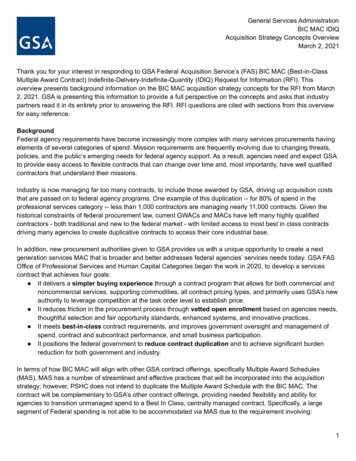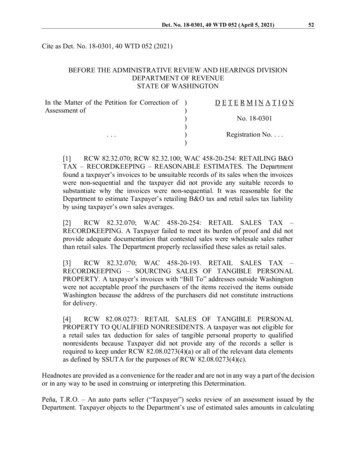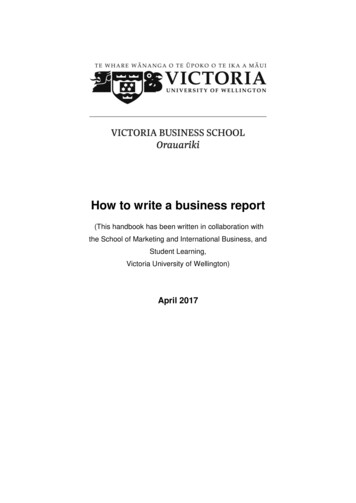
Transcription
General Services AdministrationBIC MAC IDIQAcquisition Strategy Concepts OverviewMarch 2, 2021Thank you for your interest in responding to GSA Federal Acquisition Service’s (FAS) BIC MAC (Best-in-ClassMultiple Award Contract) Indefinite-Delivery-Indefinite-Quantity (IDIQ) Request for Information (RFI). Thisoverview presents background information on the BIC MAC acquisition strategy concepts for the RFI from March2, 2021. GSA is presenting this information to provide a full perspective on the concepts and asks that industrypartners read it in its entirety prior to answering the RFI. RFI questions are cited with sections from this overviewfor easy reference.BackgroundFederal agency requirements have become increasingly more complex with many services procurements havingelements of several categories of spend. Mission requirements are frequently evolving due to changing threats,policies, and the public’s emerging needs for federal agency support. As a result, agencies need and expect GSAto provide easy access to flexible contracts that can change over time and, most importantly, have well qualifiedcontractors that understand their missions.Industry is now managing far too many contracts, to include those awarded by GSA, driving up acquisition coststhat are passed on to federal agency programs. One example of this duplication -- for 80% of spend in theprofessional services category -- less than 1,000 contractors are managing nearly 11,000 contracts. Given thehistorical constraints of federal procurement law, current GWACs and MACs have left many highly qualifiedcontractors - both traditional and new to the federal market - with limited access to most best in class contractsdriving many agencies to create duplicative contracts to access their core industrial base.In addition, new procurement authorities given to GSA provides us with a unique opportunity to create a nextgeneration services MAC that is broader and better addresses federal agencies’ services needs today. GSA FASOffice of Professional Services and Human Capital Categories began the work in 2020, to develop a servicescontract that achieves four goals: It delivers a simpler buying experience through a contract program that allows for both commercial andnoncommercial services, supporting commodities, all contract pricing types, and primarily uses GSA’s newauthority to leverage competition at the task order level to establish price. It reduces friction in the procurement process through vetted open enrollment based on agencies needs,thoughtful selection and fair opportunity standards, enhanced systems, and innovative practices. It meets best-in-class contract requirements, and improves government oversight and management ofspend, contract and subcontract performance, and small business participation. It positions the federal government to reduce contract duplication and to achieve significant burdenreduction for both government and industry.In terms of how BIC MAC will align with other GSA contract offerings, specifically Multiple Award Schedules(MAS), MAS has a number of streamlined and effective practices that will be incorporated into the acquisitionstrategy; however, PSHC does not intend to duplicate the Multiple Award Schedule with the BIC MAC. Thecontract will be complementary to GSA’s other contract offerings, providing needed flexibility and ability foragencies to transition unmanaged spend to a Best In Class, centrally managed contract. Specifically, a largesegment of Federal spending is not able to be accommodated via MAS due to the requirement involving:1
Non-commercial servicesCost Reimbursable contract typesIntegrated servicesAs such, the above needs represent top priority objectives for the Government’s requirements. PSHC does notintend to limit BIC MAC to these parameters, though; the goal is to provide a flexible, dynamic contract vehiclethat can meet the full scope of potential services needed, which may also include commercial and fixed pricerequirements. How this will relate to other Multiple Award Contracts and Government-Wide Vehicles is still beingdetermined within GSA.Lastly, GSA would like to clarify any confusion about the name for this contract vehicle. Please note that BICMAC, B.I.G. MAC, Next Generation Services IDIQ, and all renditions of OASIS 2 (expanded, next gen, etc) arethe same contract as the BIC MAC. The final name for this contract has not been decided, and will be referred toas BIC MAC until a name is decided.Acquisition Strategy Concepts OverviewPlease note that all concepts shared in this overview are preliminary and in constant flux. The intent of theexamples and walk through is to help aid comprehension and they do not represent any final concepts. Theseideas are being actively discussed with industry, customer agencies, and GSA’s acquisition policy office todetermine viability and interest.This overview will go over conceptual plans for GSA’s BIC MAC IDIQ Contract Organization, Small BusinessStrategies, Ordering Process, Source Selection, and Pricing Data. It is important to understand the entire processbefore diving into the RFI.1.Contract organization and Domains1.1.GSA’s intent is for the BIC MAC contract to be one contract organized by domains. A domainrepresents a grouping of related functional areas that encompass multiple NAICS codes. Domainsare designed to align order requirements to qualified industry partners. A company would qualifyfor the domain as a whole and therefore qualify for all of the NAICS codes aligned to that domain.Domains do not have a primary NAICS code, instead, the ordering contracting officer would selectany NAICS code within the domain based on the principle purpose of their requirement.1.1.1.The above example is presented to show how NAICS may be grouped under a domain tohelp with the following statements. These examples are not inclusive of all planneddomains or NAICS.2
1.1.2.2.3.To issue their solicitation, the CO would select the domain best aligning to theirrequirements, as well as the NAICS under the domain associated with the principal purposeof the task order work. It is not anticipated that competing a requirement across multipledomains would be permitted (i.e., the OCO chooses a single domain to solicit from). Thechosen order-level NAICS code will set the applicable size standard on a procurement byprocurement basis. This means that a company may be both large and small within a givendomain, depending on the NAICS codes. The ordering NAICS would determine theapplicability of a company’s ability to compete if a small business set aside is used, not theDomain.1.1.3.Another important consideration is that a NAICS code can appear in multiple domains, asshown in the example. This structure will allow a company to clearly and appropriatelymatch their capabilities to a domain or multiple domains. Additionally, it will allow agencybuyers to identify the appropriate domains and industry partners that perform the type ofwork they’re looking for no matter which NAICS defines the principle purpose of work. Forexample, 541611 for R&D is much different than 541611 for Human ResourcesManagement. A similar concept exists on schedules: 541611W - Workforce Analytics andEmployee Records is for NAICS 541611 work, but aligned to the Human Capital schedule;541611O is same NAICS but aligned to office management, 541611 (general) is aligned tothe professional services schedule, while 541611LIT is aligned to litigation support servicesunder office management/document services.Domains and Scope2.1.At this time, GSA is anticipating 9 to 15 domains in the initial release of the contract. The domainswill follow a category management structure with some specialized domains based on agencyneeds and where category management has gaps. Which domains will be in the rollout of thecontract are to be determined. Current assumed domains are as follows:2.1.1.General domains: Technical and Engineering, Research and Development, Managementand Advisory Services, Business Administration, Financial Services, EnvironmentalServices, Marketing and PR, Logistics, Facilities, Human Services (HR, Legal, and SocialServices)2.1.2.Specialized domains Identified to date: Base Operation Support Services,Counterintelligence, C4ISR, Major Professional Services Acquisitions (large dollar valuecomprehensive professional services), OCONUS2.2.GSA is looking to create the ability to create more domains as the contract progresses in casethere are areas of scope that would merit additional breakouts. This would be determined based onoverall need from customer agencies, the representation of industry, and other factors.2.3.The next RFI will ask for feedback on domain requirements, the NAICS codes that should beincluded, and considerations for additional scope areas.Domains and Small Business Strategies3.1.One of the priority goals for BIC MAC IDIQ is to reduce contract duplication, which benefits bothGovernment and industry, particularly small business concerns. To that end, GSA is exploring theuse of Small Business Reserves, rather than having separate contracts for small and largebusinesses.3.1.1.Given the potential variance in size for one company within a domain, one contractprevents undue administrative burden by having to develop entire proposals to supportawards on separate contracts for the same area of work. Also, combining small and largebusinesses in the same contract allows agency contracting officers to solicit to bothbusiness sizes simultaneously if market research does not clearly demonstrate the ability toset aside the requirement for small businesses. It also makes market research easier as awhole.3
3.2.4.Recent changes to Federal Regulations (13 CFR § 121.404(a)(1)) require small businesses tore-represent their size and socioeconomic status per task order if the task order socioeconomic setaside differs from the IDIQ’s (e.g., a WOSB set aside task order under a SB set aside IDIQ). Therule does not require order-level representation, however, if the agency issues the order under apool or a reserve that already was set aside (or Reserved) for the same category as the order atthe IDIQ level.3.2.1.The utilization of reserves as an acquisition strategy, could potentially avoid the need fordistinct, duplicate contracts for every type of socioeconomic category, and allow smallbusinesses to compete for any procurement issued under a domain, whether theprocurement is set aside or not.3.2.2.Use of reserves could allow the small businesses to maintain their size/socioeconomicstatus for the five-year contract term in any eligible socioeconomic reserve groups, exceptas required to re-represent by FAR 52.219-28 or if the ordering agency contracting officerexplicitly requests re-representation at the order level (which would not affect thesize/socioeconomic in the IDIQ).Customer Ordering Process4.1.This contract will follow a systematic design and approach. What that means is, GSA will makeavailable to customer agencies any vendor capabilities and project experience related to proposaldata verified at the IDIQ level that could facilitate order-level market research and task ordersource selection.4.1.1.There would be an exception for secret (and above) experience.4.2.This customer marketresearch model is shown to helpindustry understand the justification forthe data requested related to projectexperience during source selection.This example represents a concept formarket research capabilities using thesystem that GSA may provide.4.2.1.All numbers usedin the example are fictitious and do notrepresent any concepts for caps orratios of the Research andDevelopment Domain, nor do thenumbers under a given sectionrepresent any known figures onindustry capabilities.4.2.2.In this examplefor Research and Development, theagency buyer has identified the NAICScode that they want to research orsolicit under. There are 120 vendorsavailable in the given domain. For theNAICS in question, 541715, 60 of themare large businesses and 60 are small.In order to identify vendors with thespecific capabilities needed for theirrequirement, the buyer has selectedtwo key functional categories under4
5.Research and Development - Medical R&D and R&D with Systems IT4.2.2.1.These functional categories would be defined by GSA through a partnership withindustry and customer agencies. They would be fixed within the system, and wouldbe used to ‘tag’ project experience that a vendor provides in the company profile.The functional categories would be flexible, in that GSA could add or removefunctional categories at any time based on customer and industry input. The intentof the categories (tags) is to assist with market research and vendor identification,not limit fair opportunity.Company Experience5.1.As vendors submit project specific experience in their proposals to add domains to their contracts,or add or update content to their company’s project experience profile at a later date, vendorswould provide the same type of information that is being searched against by ordering agencies asthey are conducting market research.5.1.1.In the example shownhere for project experience, the company hassubmitted their experience working on aResearch and Development project that hasboth Medical R&D as well as R&D with SystemsIT. The vendor tagged their experience basedon the scope of work for the project. Thecompany would be shown as a match during theordering agency’s market research, along withthe other vendors that also indicated that theyhad project experience that matched theordering agency’s criteria.This project has been tagged for multipledomains. The intent would be that a project istied to the vendor’s profile and could be usedacross domains when providing evidence ofexperience and capabilities. It would only needto be submitted once by the vendor, and verifiedonce by the Government.5.1.2.The idea here is tominimize the incidence of vendors entering thesame qualifications and project experienceinformation many times, in many differentformats to comply with slightly differentparameters. Once GSA has verified thefundamental qualification, the vendor andordering agency contracting officer can rely onthat qualification, or add to it with order-levelsupplemental information as needed.5.2.Currently, GSA is considering how to educate customers on the use of the systematic tool to alsoset minimum Order Level Qualifications. Order level qualifications would be criteria established bythe ordering contracting officer to do an initial vetting of industry capabilities. GSA intends to clearlyidentify the capabilities and certifications that have already been verified and vetted at the mastercontract level. Via this method, if an OCO requirement calls for proof of an Adequate CostAccounting System as a minimum order level qualification, for example, they will identify theminimum need in their evaluation criteria for award consideration. It would limit who would meet5
6.minimum qualifications for award at the task order level, and this and other information would beavailable to the OCO via GSA for each and every contract awarded under the program. How thiswould work in a subcontracting situation is to be determined, and it would still be the OCO’sdiscretion to determine how they would use the Order Level Qualification information that GSA hasverified and vetted. It is important to mention that order level qualifications can be updated/addedto a contract at any time during the life of the contract. So, if for instance a contractor is awarded acontract under the program and their Cost Accounting System hasn’t been determined adequate atthe time of award, once it has the designation, the contractor can request to have the designationadded.5.3.As mentioned, GSA plans to make project experience available to support a customer’s marketresearch. In order to have a complete profile, vendors can submit project experience at any timeand will be incentivized to keep their project experience information up-to-date. PSHC will verifyupdated information on an ongoing basis, and will work to streamline and automate much of thisprocess to support a quick turnaround.Source Selection - IDIQ6.1.The current plan is not to cap the number of awards made under each domain. So long as avendor meets the solicitation’s minimum technical qualifications identified for each individualdomain they are proposing to, they would receive an award and that domain would be included intheir contract.6.2.In addition, GSA intends to have continuous entry of new awardees.While it is not decided whetherthis would mean the solicitation is always open, or is open during multiple windows throughout theyear, it does mean we do not plan to limit entry opportunities.6.3.Also, GSA anticipates using the authority provided to the agency to enhance competition at thetask order level by eliminating price as an evaluation factor for the master IDIQ contract award.6.4.To be eligible for award of a domain, vendors will need to provide project experience andcapabilities specific to that domain based on a minimum set of qualifications and criteria. To themaximum extent possible, GSA will standardize submission requirements across domains to limitthe amount of “new” information vendors will provide when applying for additional domains.6.5.The evaluation criteria for each domain will vary, and there is no set evaluation criteria orqualification threshold that carries across all domains. In fact, the system will be verifying whethervendors have met the minimum overall criteria to qualify to join a domain or domains, rather than“scoring” your entries. Let’s talk about what this means.6.5.1.In this example, wehave created a mock set of criteria for theResearch and Development Domain.6.5.1.1.This exampleis simplified for illustrative purposes anddoes not represent the end state. Additionaldetails on source selection criteria for eachdomain will be provided in the second RFI,where respondents will have the opportunityto provide feedback. GSA is working inpartnership with customer agencies to definethe draft criteria in the meantime.6.5.2.As can be seen, therequirements to qualify for the specificDomain award would be very clear. Theconsiderations for small business specificqualifiers are not yet defined and will be6
7.8.developed as a result of market research and stakeholder engagements.6.5.3.A vendor would be able to join additional domains at a later date. If they qualify for onedomain today, but need additional experience to qualify for another domain, they cansubmit that experience later for evaluation to be considered. As was mentioned earlier,project experience could be used across domains as well, and if a project was alreadysubmitted, it would not need to be resubmitted to be considered, just linked to that domainfor the evaluation.6.5.4.Through continuous open enrollment, clearly defined criteria, and varied requirements bybusiness size, GSA is hoping to address several issues that arise from a ‘race to qualify’ bythe closing date mentality.6.5.5.If the contract is always open, GSA is developing considerations for off-ramping andevaluating vendor performance and participation. Many of the suggestions and concepts forthis came directly from industry. There are no specific strategies outlined at this stage, butthere will be questions about the types of methods and measures that GSA mightimplement in a later RFI.Additional Considerations for Small Business Strategies7.1.For contractor teaming arrangements, including Joint Ventures and Prime/Subcontractor teams(see FAR 9.601), GSA is exploring multiple options for how that experience and relationship shouldbe considered. While there has been early feedback that continuous onboarding may reduce theneed for vendors to rely on teaming arrangements to qualify for award, we are still consideringvarious risk mitigation strategies to ensure awardees are sufficiently qualified
i nt end t o l i mi t B I C MA C t o t hese paramet ers, t hough; t he goal i s t o provi de a f l exi bl e, dynami c cont ract vehi cl e t hat can meet t he f ul l scope of pot ent i al servi ces needed, whi ch may al so











